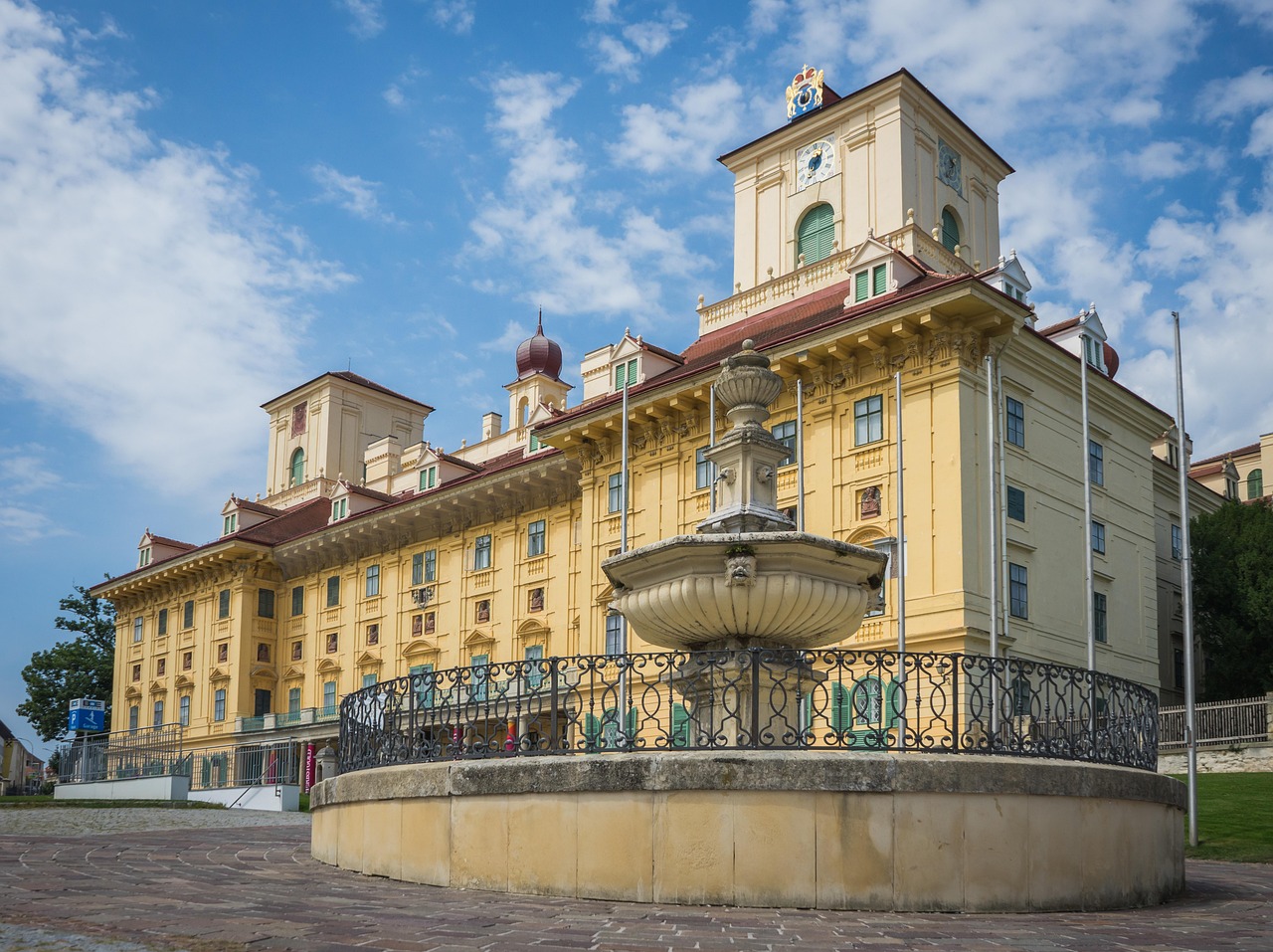Experience Travel Insights
Taste the Symphony: The Legendary Trio of Esterhazy, Blaufränkisch & Josef Haydn
by Long Lin-Maurer • September 25, 2025

Esterhazy Blaufränkisch & Josef Haydn: A Symphony of Wine and Music
The Prince, The Kapellmeister, and The Wine: A Pannonian/ Hungarian Rhapsody
In the sun-drenched plains of Burgenland, where Austria gently slopes towards the Hungarian frontier, the land itself seems to hold a melody. Here, under the vast Pannonian sky, a unique cultural tapestry was woven from threads of immense power, artistic genius, and the deep, ruby-red bounty of the earth. This is the story of the House of Esterházy, their legendary court composer Josef Haydn, and the noble Blaufränkisch grape. The unique relationship between Esterhazy, Blaufränkisch, and Josef Haydn forms a trinity that defines the soul of this region and offers a taste of history that continues to resonate today. To understand one is to better appreciate the others; together, they compose a symphony of culture, patronage, and terroir.
Come and experience travel!
Personally designed, seamlessly delivered – your journey, our expertise!
We are a boutique travel agency and consultancy specializing in Hub & Spoke Tours across Central Europe, the Benelux and the Dolomites.
The House of Esterházy: Architects of a Cultural Realm
For centuries, the House of Esterházy was more than just a noble family; it was a force of nature in Central Europe. Their influence, wealth, and political acumen were legendary, rivaling that of the Habsburg emperors they served. Yet, their most enduring legacy was not forged on the battlefield, but in the concert halls and salons of their magnificent palaces. The Esterházy princes were visionary patrons of the arts, understanding that cultural splendor was the ultimate expression of power and prestige.
Their primary seat in Eisenstadt, the magnificent Schloss Esterházy Eisenstadt, was not merely a residence but a vibrant cultural capital. Its opulent rooms, particularly the grand concert hall now known as the “Haydnsaal,” were designed with acoustics so perfect they continue to be revered by musicians worldwide. It was here that the family’s orchestra, one of the finest in Europe, performed. The princes didn’t just fund the arts; they curated an environment where creativity could flourish on an unprecedented scale. They commissioned operas, oratorios, and symphonies, transforming their court into a beacon of the Enlightenment, a place where art was integral to the fabric of daily life.
The Kapellmeister’s Contract: Josef Haydn’s Salary in Wine
Into this world of cultivated splendor stepped Josef Haydn in 1761. Hired as Vice-Kapellmeister and later promoted to Kapellmeister, he would spend nearly thirty years in the exclusive service of the Esterházy princes, primarily Prince Nikolaus I, “the Magnificent.” This relationship was the cornerstone of Haydn’s career, providing him with a stability and a platform that few composers of his era enjoyed. He had a full orchestra at his disposal, singers for his operas, and an appreciative, sophisticated audience in his patron. It was a gilded cage, perhaps, but one that allowed his genius to soar.
The terms of his employment were meticulous, detailing his duties from composing music for all occasions to managing the musicians. Tucked within the clauses of his contract was a fascinating and very Austrian provision: a portion of his salary was to be paid “in kind.” This included not just firewood and grain, but also a significant annual allotment of wine from the family’s own vineyards. This “Deputatwein”—in essence, Josef Haydn’s Deputatwein—amounted to roughly one Eimer, an old unit of measurement equivalent to over 50 liters, of the domain’s finest red wine. This was not simply a perk; it was an integral part of life at court, a recognition that the land’s produce was as much a part of the Esterházy identity as the music performed in its halls. For Haydn, the wine of Burgenland was the taste of his daily existence and a sensory link to the very soil that grounded his patron’s empire.
A Symphony in a Glass: The Esterhazy Blaufränkisch of Burgenland
The wine that filled Haydn’s glass was almost certainly Blaufränkisch. This ancient, indigenous grape variety is the undisputed king of red wines in the Burgenland wine region, an area whose unique microclimate creates the perfect conditions for it to thrive. Cradled by the Leitha Mountains and moderated by the vast, shallow Lake Neusiedl, the vineyards are protected from harsh Alpine winds and benefit from a warm Pannonian climate with sun-filled days and cool nights. This climate, combined with mineral-rich soils of schist, limestone, and loam, imbues the Blaufränkisch grape with its signature character.
A well-crafted Blaufränkisch is a wine of profound depth and elegance. It is not a bombastic, fruit-forward wine, but one of structure, spice, and sophistication. In the glass, it presents a deep ruby or violet hue. The nose is a complex bouquet of dark berries—blackberry and sour cherry—mingled with intriguing notes of black pepper, clove, and a subtle, earthy minerality that speaks directly of its origins. On the palate, it reveals firm tannins and a vibrant acidity that give it remarkable longevity and make it an exceptionally versatile companion to food. It is a wine that rewards contemplation, evolving in the glass, much like a Haydn symphony reveals its intricate layers. The composer Haydn’s Blaufränkisch would have been a true reflection of its Pannonian home: warm and generous, yet with an underlying structure and a noble, slightly wild spirit.
Come and experience travel!
We design bespoke travel experiences with a perfect balance of cultural depth, efficiency and comfort.
Specializing in seamless hub-and-spoke journeys, we create well-paced, immersive itineraries tailored to your interests.
Tasting History: The Enduring Legacy of Esterhazy Wine and Haydn
The remarkable thing about this story is that it is not confined to the pages of history books. It is a living, breathing legacy that can be experienced today in a way that is both profound and deeply personal. A journey to Eisenstadt and the surrounding Leithaberg region is a journey into the heart of this unique cultural symbiosis.
One can stand in the glorious Haydnsaal at Schloss Esterházy, its frescoes gleaming, and almost hear the faint echoes of the first performances of Haydn’s “Farewell” Symphony. Just a short, scenic drive away, the Esterházy winery continues a tradition of viticulture that spans over 300 years. They are the custodians of the very same vineyards that supplied the princely cellars and the Kapellmeister’s table.
To visit the modern winery is to witness a seamless blend of heritage and innovation. While honouring a rich viticulture history, they employ state-of-the-art techniques to produce wines that are among Austria’s most celebrated. A tasting of their Blaufränkisch from the Leithaberg DAC—a designation signifying the highest quality and regional typicity—is a transcendent experience. As you sip this classic Austrian red wine, with its characteristic notes of dark fruit and savory spice, you are quite literally tasting the same terroir that shaped Haydn’s world. Haydn’s Esterhazy wine becomes a conduit to the past, a sensory key that unlocks a deeper understanding of the composer’s life and the magnificent court he served.
This connection between the land, the music, and the history creates a travel experience of unparalleled richness. It is a journey that engages all the senses: the sound of a string quartet in a hall built for acoustical perfection, the sight of vine-covered hills rolling toward the horizon, the taste of a wine that encapsulates the very soul of the region. It is a reminder that the greatest cultural treasures are not merely objects in a museum; they are living traditions, stories waiting to be rediscovered, and symphonies waiting to be heard—and tasted.
Information on Esterhazy, Blaufränkisch, and Josef Haydn: A Cultural Heritage Perspective
- Esterházy Family History: Provides an overview of the Esterházy family’s centuries-long history and their significant role in Central European culture and politics.
- Josef Haydn’s Life at Esterházy: Details Josef Haydn’s pivotal years of service with the Esterházy family, highlighting his creative environment and daily life in Eisenstadt and Esterháza.
- Blaufränkisch Grape Variety Profile: Explores the historical origins, characteristics, and viticultural significance of the Blaufränkisch grape in Austria, particularly Burgenland.
- History of Schloss Esterházy Eisenstadt: Chronicles the architectural and cultural evolution of Schloss Esterházy, the main residence where Haydn composed and directed music for the princely court.
- Burgenland Wine Region History: Offers insights into the historical development of viticulture in Burgenland, a region closely associated with the Esterházy estates and Blaufränkisch production.
- Haydn’s Creative Period at Esterháza: Examines the peak of Josef Haydn’s compositional output during his later tenure at Esterháza, under the continued patronage of the Esterházy princes.
- 18th-Century Viennese Food & Drink Culture: Provides context on culinary traditions and beverage consumption in 18th-century Austrian aristocratic circles, including wine’s prominent role.
- Esterházy’s Broader Cultural Patronage: Illustrates the Esterházy family’s extensive support for arts and culture beyond music, including architecture, painting, and garden design, shaping regional heritage.
- Scientific Background of Blaufränkisch (Kékfrankos): Presents scientific data on Blaufränkisch, including its genetic lineage and ampelographic characteristics, from a plant genetic resource database.
- Austrian Winegrowing as Intangible Cultural Heritage: Documents the recognition of Austrian winegrowing as an intangible cultural heritage by UNESCO, highlighting its deep-rooted cultural significance and traditional practices.
